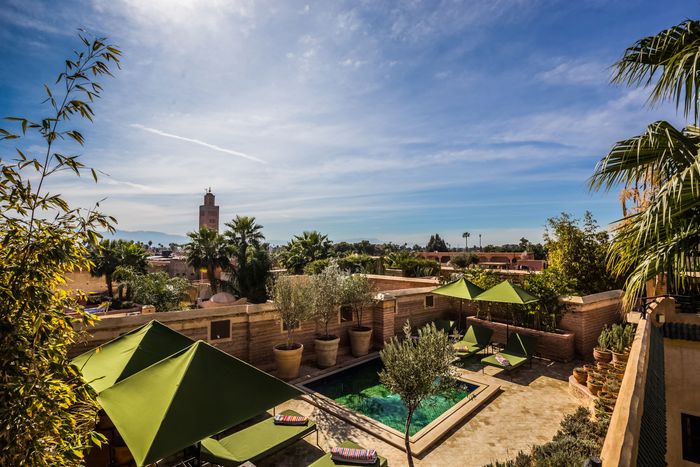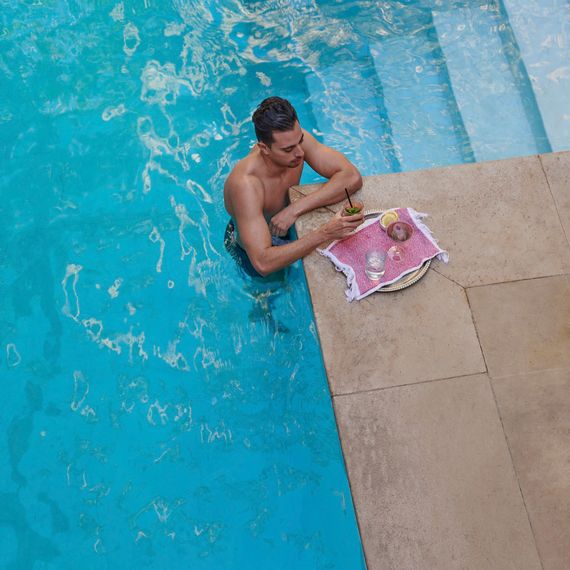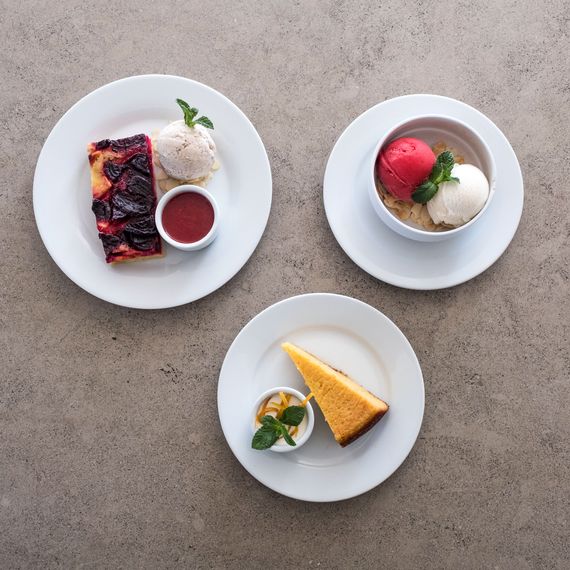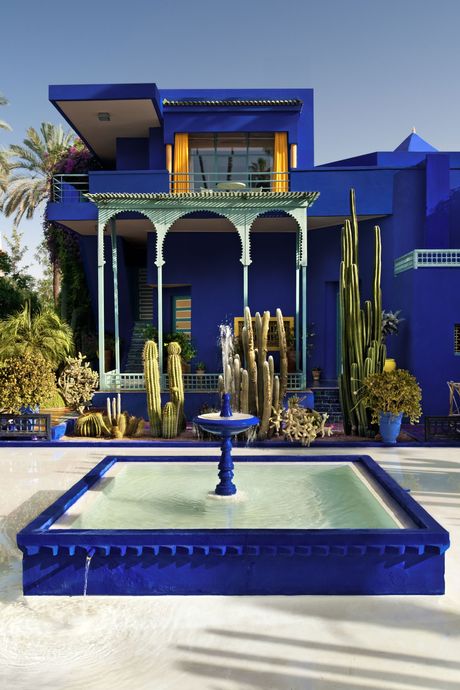
It’s commonly understood that the best way to explore a new place is to go straight to the locals. Each week in the Urbanist, we take that wisdom one step further by seeking out not just locals but local experts — those who are especially well versed in their cities’ newest and most noteworthy scenes — to give us insider recommendations. This week, we asked contemporary artist and photographer Hassan Hajjaj, who’s been called the “Andy Warhol of Marrakech,” for his picks in the Moroccan city.
“Marrakech will wake up your senses to the fullest. It has a lot of personality. The lights, the people: that’s why I think it’s a photographer’s dream. My favorite things to photograph in Marrakech are people. When I’m outside, I’m like a tourist like everybody else, kind of curious. I might see a local barber shaving somebody’s head in the market underneath a plastic canopy. The people of Marrakech are very special. They’re very funny, they can joke. The food, if you can find the right places, is great. If you go to locally run places, you’re gonna get more of a feel of the city. There’s a rhythm within this city. I call it ‘organized chaos.’ ”
His Other Musts
Hotel



“The El Fenn (Derb Moullay Abdullah Ben Hussain) is a very beautiful boutique hotel. It’s quite a few riads put together and very accessible to the medina and the Jemaa el-Fna square, less than a ten-minute walk. You still have this reflection of Morocco because of the riad, but the design is very contemporary — some rooms are accented with mid-century lamps and tables, Wassily chairs, and freestanding clawfoot tubs. Riad, which means garden in Arabic, is normally a big house for multiple families with a big garden in the middle. The inner garden or courtyard will have a fountain and lots of trees and plants. You can hear the sound of the water and birds inside the space. It’s almost like living inside out.”
Café
“There’s definitely a café culture here. Lots of business gets done in café s, lots of hanging out, and friends meeting up. Cafe Extrablatt (Hivernage) has a great patio and a big Mediterranean menu. Plus, it’s in a nice neighborhood, Gueliz. Order a nous nous — it’s what locals order. It’s half milk, half espresso. Cafe Bistro Laksour (Rue Lalla Fatima Zahra) is another great one. The space and menu are smaller than Extrablatt, but it’s right at the doorway of the medina.”
Moroccan Restaurants



“Al Fassia (55 Boulevard Mohamed Zerktouni), which is run by women, serves very traditional Morroccan food that’s almost like homemade cooking, from couscous to tagine to mechoui (barbecue) to pastilla, which is chicken cooked with cinnamon in a pastry. Nomad (1 Derb Aarjane) is right in the middle of the old medina and looks over a small square. The restaurant has four floors but definitely sit on the rooftop terrace, where you can see the medina and Atlas mountain range. The food is very contemporary, like Moroccan gazpacho, sardine tart, and a spiced lamb burger. The Amal Center (Rue Allal Ben Ahmed) has a great restaurant in Guéliz. It’s run by women and part of a nonprofit organization that helps women through restaurant training. It’s an old villa from the ’30s that’s turned into a restaurant. At Amal, they do a different dish every day, but on Fridays they do just couscous: chicken, beef, and vegetarian. That’s a traditional day to eat couscous after mosque. The fine dining restaurant Dar Moha (81 Rue Dar El Bacha) is named after the chef Moha Fedal, who is said to have reinvented Moroccan cuisine. (The Duke and Duchess of Sussex recently ate there.) The food there is amazing. Dinner is prix fixe and includes pastilla, tagine, couscous, and desserts like caramelized-apple shakshouka and orange salad.”
Museums and Galleries
“Comptoir des Mines Galerie (62 Rue Yougoslavie), run by Hicham Daoudi, is one the galleries that shows Morroccan contemporary artists. They have openings every few months in a beautiful 1930s building. Galerie 127 (127 Avenue Mohammed V) is a photography gallery run by Nathalie Locatelli. I think she has a brilliant eye for photography. There’s also the Museum of African Contemporary Art Al Maaden (MACAAL), which is the newest museum for African art in Marrakech. At the moment, they’re showing Mohamed Melehi. The Farid Belkahia Foundation is the house, and now museum, of a very famous artist who passed away two years ago. This year I’m going to be showing my work there in an exhibition opening October 26 and introducing 15 Morrocccan photographers as a part of my show.”
Shopping



“Amine Bendriouich is one of the most interesting fashion designers in Morocco. He’s more of an artist-designer. The patterns he does are really interesting. He plays around with different fabrics. Some of his designs are more like sculptures. He has a shop, Amine Bendriouich Welcome to the Kingdom, at the SHTATTO concept store (81 Derb Nkha) in the medina. At SHTATTO, there’s three shops and a café on the roof, which has a 360-degree view of Marrakech. It’s a really nice place to shop and have a coffee. Yahya (61 Rue Yougoslavie) does very, very beautiful sculptural lights. They look very traditional, but there’s something very special about them. They have a new shop in Guéliz. It’s like two minutes away from the Comptoir des Mines Galerie. Soufiane Zarib (16 Rue Sidi Ali Ben Hamdouch) is where you want to go for carpets. He has traditional hand-woven Berber carpets plus his own colorful, contemporary designs. The 33 Rue Majorelle concept store (33 Rue Yves St Laurent) has really interesting clothing from up-and-coming Moroccan brands and designers. There’s a shop I really like called Beldi (9-11 Soukiat Laksour) that’s doing beautiful cashmere and silks. It’s very chic, very Moroccan, but the pieces don’t look like traditional clothing that you get in the market.”
Hammam
“Spas here are a totally different experience. You’ll either love it or it will be shocking. When my friends come, I usually take them to a very local one like Places des épices (156-157, Derb Aârjane Rahba Lakdima) across from Nomad restaurant. There’s a whole ritual of a hammam. You have to make sure you take your towel, your clean clothes, your shampoo, your soaps, a pair of plastic slippers, a small bucket you can wash yourself with. The most important thing to take is savon beldi, the Moroccan black soap. When you go in, there’s three rooms. You go into the first room, which is the hot room, and sit there for maybe 5, 10, 15 minutes — whatever you can take — and then you put the black soap on you. You leave it for five minutes, wash it off, then you get the person who works there to scrub you with this glove. That gets all the dead skin and dirt off you. After you do that, they can stretch you out — it’s different than a massage. Then, you go into the next room and wash yourself. And then you go into the third room, which is the cooler one, and relax for a few minutes. And then you go out to a little salon to recline for 10 to 20 minutes because the whole process can be overwhelming and really tire you out.”
Attractions


“Jardin Majorelle (Rue Yves Saint Laurent) is a classic. It’s the No. 1 tourist destination in Marrakech, but well worth the trip. The French painter Jacques Majorelle opened up his private garden to the public in 1947. Then in 1980, Yves Saint Laurent and Pierre Bergé bought and restored it. It’s a very beautiful, very big garden. Walk around there and then go to Café Majorelle and the boutique, which has handmade Moroccan artisan goods, that are on the property. The Musée Yves Saint Laurent (Rue Yves Saint Laurent), which is right next door to the garden, is quite new and definitely worth checking out. It’s only a few years old, done by two French architects, Karl Fournier and Olivier Marty. The museum has a permanent retrospective of Yves Saint Laurent’s work as well as rotating exhibits on fashion, art, and design.”
Day Trip
“I love going to Kasbah Bab Ourika (Ourika, Morocco) to rest. It has 26 rooms, which all have private terraces or pools and are decorated in warm earth tones. It’s on a hilltop, and you can see the Ourika Valley and the Atlas Mountains. It’s an hour drive from Marrakech. If you’re there on a Monday, in the village below, there’s a local market. You buy some vegetables and meat, and they’ll cook it for you right there. Or the hotel restaurant serves dishes like charcoal-cooked beef tagine and spicy lentil fritters made with organic ingredients from its own garden and the local market. If you want to really relax, go here.”
More Destinations
- The Urbanist’s Guide to Approachable, Unusual Hikes
- The Urbanist’s Guide to the Beaches of New Jersey
- The Urbanist’s Guide to Tucson



